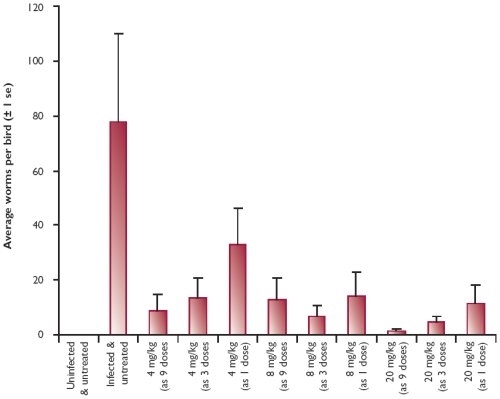Key findings
- Worm burden is inversely related to the size of dose of anthelmintic drug.
- The frequency of dose influences clearance of T. tenuis parasites, with multiple doses providing better clearance.
The caecal nematode, Trichostrongylus tenuis, causes poor breeding success and periodic population crashes in red grouse. Our research has focused on the control of parasite burdens through medicated grit. However, the efficiency of this approach is influenced by the frequency with which grouse visit medicated grit piles and the amount of grit they consume. Thus the dose rate varies from bird to bird and from moor to moor, depending on the availability and use of alternative sources of grit. This will affect treatment success.
On our rearing field we assessed the efficacy of different flubendazole (Flubenvet) treatments on the clearance of T. tenuis, using grey partridges as a model for grouse. This drug belongs to a large family of anthelmintic benzimidazole compounds and is closely related to fenbendazole (Panacur), the active ingredient in medicated grit.
We infected flock-housed worm-free adult grey partridges with 4,000 T. tenuis larvae each. Two weeks later, following the establishment of T. tenuis infection, we treated orally groups of 10 birds at total dose concentrations of four, eight and 20mg/kg body weight of flubendazole over a nine-day period. Additionally, each of these three doses were split, such that birds were treated either on a daily basis, three times, or only once during the nine-day treatment. This potentially mimicked how wild red grouse use medicated grit. Over the course of the experiment we moved the birds onto fresh ground to prevent them from recycling the T. tenuis infection.
In all the birds' caeca we counted the worms 14 days after treatment. Figure 1 shows the reductions in worm burdens achieved by the different dosing regimes, and demonstrates that 20mg/kg administered daily gives the best clearance of T. tenuis. This resulted in a reduced worm burden of just 3.5 per bird compared with 139.6 in the untreated control group - a reduction of 97.5%. All treatments gave appreciable reductions in worm burdens in the grey partridges, but at each of the three concentrations, a single dose was the least effective in reducing trichostrongle numbers.
Figure 1: Average number of Trichostrongylus tenuis per grey partridge (geometric mean ± 1se) 37 days after infection in relation to dose size and frequency
